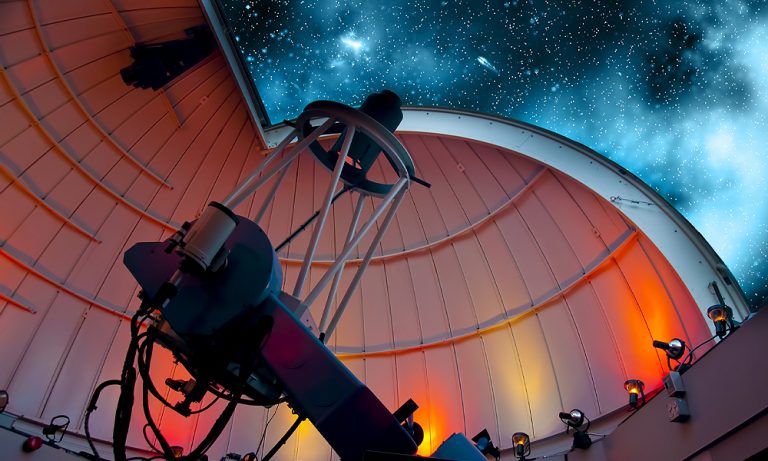12 Best Computerized Telescopes Worth the Money (2024)
A computerized telescope isn’t for everyone. Usually, it’s more expensive and doesn’t offer the value you can get with manual Dobsonians.
BUT, you can see things like messier objects way quicker, with more precision.
It automatically tracks and targets so that whatever you are looking at stays centered in the eyepiece rather than drifting out of view after a few seconds.
The best computerized telescope has a large aperture, automatically tracks at least 14,000 celestial objects, and is reasonably portable. Here are our favorites.
Best Computerized Telescope
1. Celestron NexStar 6SE Computerized Telescope
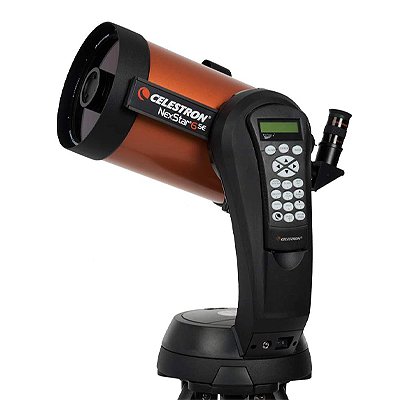
The Celestron NexStar 6SE Telescope is the best all-around mid-price GoTo telescope.
While it is advertised for both beginners and advanced users, it’s the perfect telescope for an intermediate user.
It comes with a fully-automated GoTo motorized mount with a database of over 40,000 objects.
The 150 mm aperture provides enough light collection for incredible viewing within our Solar System, but it’s not the greatest for viewing DSOs.
The NexStar 6SE is a fantastic choice for astrophotographers or anyone who wants to dive into the field (though it doesn’t come with any adapters).
The telescope comes with a 25mm Plossl eyepiece, a red-dot finderscope, and access to astronomy software, Starry Night.
What we liked
- An excellent choice for intermediate users
- Superior optics for viewing our Solar System
- Great for astrophotography (need adapters)
- Lightweight and portable
What we didn’t like
- Not the best at viewing DSOs
Optical Type: Reflector (Schmidt-Cassegrain)
Aperture: 150mm
Focal Ratio: f/10
Magnification: 60x
Weight: 30 lb
2. Celestron CPC 1100 GPS XLT Computerized 11″ Schmidt Cassegrain Telescope
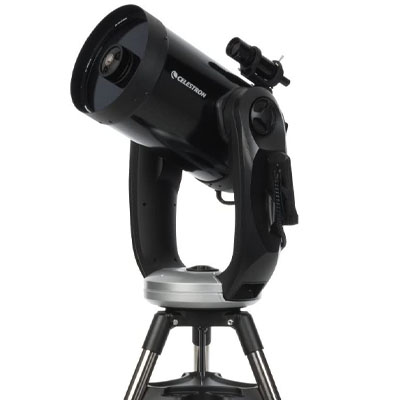
Cassegrain Telescope. It is the perfect electronic telescope to take you from intermediate to advanced levels. The optics are treated with Celestron’s Premium Star Bright XLT optical coatings for exceptional views.
The telescope features a massive 280mm (11 inch) lens and a long 2800mm focal length. It comes with a large 40mm 1.25″ Plossl Eyepiece that gives 70x power magnification. Also included is a 9x50mm Finderscope for easy locating of celestial objects.
The scope comes with a fully computerized Altazimuth mount and internal GPS. The GPS makes locating objects easy as it automatically downloads information from orbiting satellites and pinpoints your exact location on Earth. It will set the date, time, longitude, and latitude.
Use the SkyAlign Alignment Technology to choose three bright celestial objects and the telescope aligns to the sky for you. The database of over 40000 celestial objects tracks any object you desire.
Although it is heavy, the innovative lift-and-move ergonomic design of this digital telescope makes it easy to carry and easy to set up, even in the dark. The tripod is made of heavy-duty steel with a central leg support bracket for added stability.
Also included is a tray to hold all your additional accessories. With this best GPS telescope, you will see amazing detail of planets, star clusters, deep-sky objects, and far-away galaxies.
What we liked
- Large 280mm (11 inch) lens
- Ergonomic design for portability
- Exceptional clarity for professional stargazers
- Computerized dual fork arm Altazimuth mount
- Internal GPS tracks your position
- Database of over 40000 celestial objects
- Hand control holder to view information hands-free
What we didn’t like
- High price for beginners
- Heavier than most
Optical Type: Schmidt Cassegrain
Aperture: 280mm (11 inch)
Focal Ratio: f/10
Magnification: 70x
Weight: 83 lbs (37.6 kg)
Mount: Computerized altazimuth mount
3. Celestron NexStar 127SLT Computerized Telescope
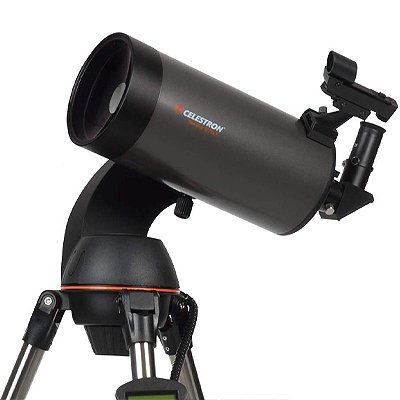
The Celestron NexStar 127SLT is another great beginner option, but with a higher aperture and a bit better power.
Though it is similar to the 90SLT, it has some distinct differences. Aside from the aperture being much higher, the computer system is practically flawless.
Its alignment software, SkyAlign, is easy and straightforward, and it’s incredibly easy to find what you’re looking for with its 40,000-object database.
It also excels at viewing both planets and deep-sky objects beyond our solar system (to an extent, of course).
However, this telescope does have similar downsides to the 90SLT. The battery life is very short, so you’ll need an external power supply, and the hand controller is difficult to learn for a beginner. The mount that’s included is also reportedly a little unstable at times.
Overall, in terms of capability and affordability, this is a great mid-range telescope for both beginners and intermediate astronomers. It comes with two eyepieces, a red-dot finderscope, an adjustable tripod, and astronomy software, Starry Night.
What we liked
- Great for beginners
- Excellent optics for viewing planets and DSOs
- Lightweight and portable
- The GoTo mount is easy to use and works exceptionally well
What we didn’t like
- The hand controller has a learning curve
Optical Type: Compound (Maksutov-Cassegrain)
Aperture: 127mm
Focal Ratio: f/12
Magnification: 60x, 167x
Weight: 18 lb
4. SkyWatcher S11800 GoTo Collapsible Dobsonian GoTo Scope
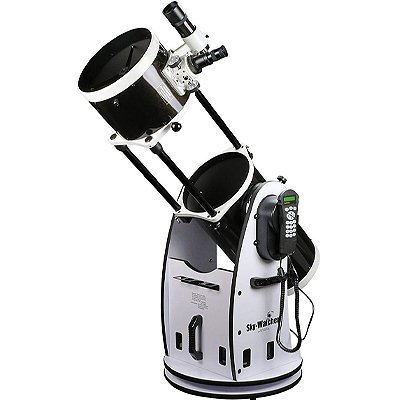
The SkyWatcher S11800 GoTo Dobsonian is a high-end computerized reflector telescope for intermediate or advanced users.
The GoTo system with this telescope is expertly designed.
It’s incredibly simple to align the telescope, it provides automatic tracking of objects at high magnifications, and it allows quick transition from automatic to manual adjusting.
The optics are high-quality and provide stellar, crisp views of planets, including Jupiter and Saturn.
While the collapsible feature is beneficial for portability, you’ll have to re-align and adjust the telescope each time you collapse it.
It’s also not exactly easy to lug around, with a base of around 35 lbs and a total assembled weight of 55 lbs. It comes with two eyepieces, a CRAY ford-style focuser, a hand controller with a database of over 42,000 objects.
What we liked
- Great upgrade-telescope for intermediate and advanced users
- Excellent optics provide crisp planetary and DSO viewing
- Collapsible design makes it easy to carry and fit in tighter spaces
- Easy to use computer system
What we didn’t like
- Requires more alignment due to the collapsable feature
- Higher price tag
Optical Type: Reflector (Dobsonian)
Aperture: 203mm
Focal Ratio: f/5.9
Magnification: 50-139x
Weight: 55 lb
5. Celestron NexStar 130 SLT Newtonian Reflector Telescope
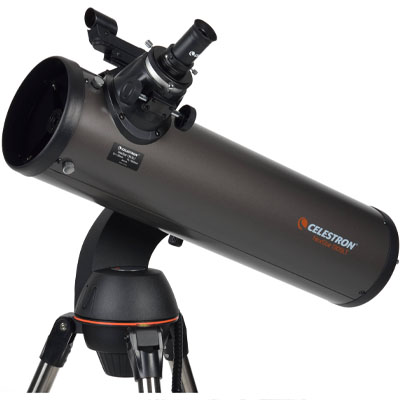
The Celestron NexStar 130 SLT Newtonian Reflector is a well-priced computerized telescope for beginners. It comes with a motorized altazimuth mount, fully computerized hand control, and SkyAlign. With this amazing feature of self aligning telescopes, you can simply center the telescope on any three bright celestial objects, and it will align to the night sky.
There is also a StarPointer Finderscope to help with alignment. Teens who are great with touch devices will soon get this going! The Celestron NexStar 130 SLT also comes with a pre-assembled, adjustable steel tripod. This is ideal for a family with smaller children, allowing for height adjustments to give them perfect sky views.
The telescope has a 130mm aperture offering crystal clear views of our solar system and other sky objects. You will see Moon’s craters as well as Saturn’s rings and Jupiter’s cloud bands. It comes with a Red Dot StarPointer Finderscope and 2 eyepieces, a 25mm, and a 9mm.
The SLT (Star Locating Telescope) has a database of more than 4,000 stars, galaxies, deep-sky objects, and more. The self-tracking telescope can easily locate your object with pinpoint accuracy and then track the object as it moves across the sky. This is a great choice for beginners and more advanced stargazers. These computerized telescopes will give years of stargazing without the need to upgrade.
What we liked
- 5 inch aperture
- Computerized hand control with 4,000+ object database
- SkyAlign to align on any three bright celestial objects
- 2 eyepieces, 25mm, 9mm
- Light and portable
- Sturdy stainless steel adjustable tripod
- StarPointer finderscope
What we didn’t like
- Sensitive to vibration
- Learning curve to start
Optical Type: Newtonian Reflector
Aperture: 130mm (5 inches)
Focal Ratio: f/5
Magnification: 26x, 72x
Weight: 18 lbs (8.16 kg)
Mount: Computerized GoTo Mount
6. Celestron NexStar Evolution 8 Schmidt-Cassegrain Telescope
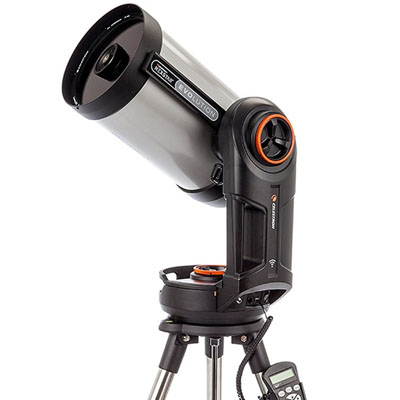
This Celestron computerized telescope has a large 8” (203mm) aperture that gives stunning views of the Moon, planets, star clusters, and deep-sky objects. It comes with 2 eyepieces, a 40mm Plossl and a 13mm Plossl. Also included is a StarPointer Red Dot reflex sight for easy locating of sky objects.
The telescope has a GoTo mount that features high-performance brass worm gears and motors for improved tracking accuracy. The younger generation enjoys using mobile apps and is sure to get this one going in a jiffy! Using the Celestron SkyPortal app, you will be able to track planets and stars across the sky.
When we are out and about, what we don’t want is a battery that runs out of power. This Celestron goto telescope gives 10-hour continuous battery use, ideal for long viewing without the stress of having to recharge when far away from a power source. It is also great for astrophotography – simply attach a DSLR camera and try your hand at snapping some amazing pictures.
Setting up the NexStar Evolution is quick and easy. It has an all-metal tripod with an accessory tray with indentations for storing and carrying the tripod. During setup, you will find leg markings to help you get a level height for your go to telescope.
What we liked
- 203mm (8”) aperture
- 2032mm focal length
- StarPointer red dot reflex sight
- 10-hour continuous use battery
- Computerized GoTo mount
- 2 Plossl eyepieces, 40mm and 13mm
- Great for astrophotography
What we didn’t like
- Higher price
- Some learning curve to get started
Optical Type: Schmidt-Cassegrain Reflector
Aperture: 203mm (8 inch)
Focal Ratio: f/10
Magnification: 51x, 156x
Weight: 40.6 lbs. (18.4 kg)
Mount: Computerized GoTo Mount
7. Celestron NexStar 5SE Computerized Schmidt-Cassegrain Telescope
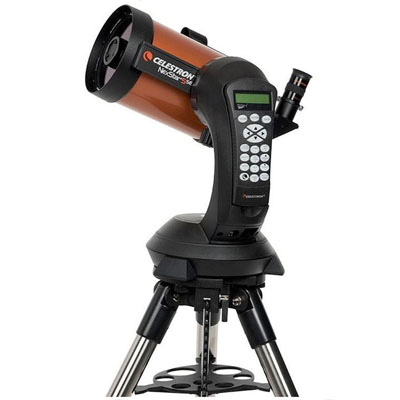
The Celestron NexStar 5SE computer controlled telescope is ideal for both a seasoned astronomer or a beginner starting out on a stargazing adventure. The first striking feature is pure fun – I love the bright orange tube! The telescope features a 5” aperture and a 1250mm focal length. It comes with one eyepiece, a 25mm that gives 50x power magnification.
These computer controlled telescopes have a fully automated GoTo mount featuring a database of more than 40,000 celestial objects. The mount will automatically locate and track objects for you.
This is a fabulous feature as you do not have to continually adjust the telescope to keep your object in view. This NexStar model is a GPS telescope and comes with an auxiliary port for use with additional accessories like a GPS. The internal battery compartment prevents cord wrap during use, a bonus when you are working in the dark.
For transporting to take along on a weekend away, it is easy to assemble and break down. The single fork arm design and sturdy steel tripod break down into separate components.
Using the SkyAlign technology for computerized tracking, you will get your telescope aligned and ready in minutes. My family enjoys a telescope that comes with astronomy software – it is a great help to get you started. The Starry Night software package has a 10,000 object database with printable sky maps.
What we liked
- 5” aperture, 1250mm focal length
- 25mm eyepiece, 50x magnification
- Computerized hand control with 40,000 object database
- Motorized altazimuth mount
- Well priced telescope with GPS connections
- StarBright XLT enhanced coatings
- StarPointer finderscope
What we didn’t like
- Too light for deep space photography
- Learning curve to get started
Optical Type: Schmidt-Cassegrain
Aperture: 127mm (5 inch)
Focal Ratio: f/10
Magnification: 50x
Weight: 27.6 lbs (12.5 kg)
Mount: Motorized altazimuth mount
8. Celestron NexStar 90SLT Computerized Telescope
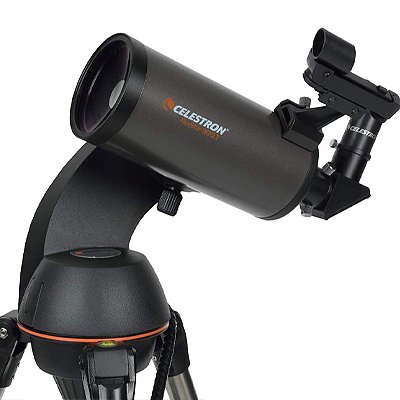
The Celestron NexStar 90SLT is an excellent entry-level telescope for those new to astronomy and on a budget.
The telescope is a combination of both reflector and refractor technology (known as compound), with well-made optics.
It excels at viewing the Sun, Moon, and other planets. Saturn is about the limit of its magnification, which will appear small, but you’ll still be able to make out the rings and some of its moons.
The computerized mount makes tracking and finding objects in the sky pretty easy.
The alignment tech it uses, SkyAlign, is quite good at detecting objects and automatically adjusting and aligning the telescope for clear viewing. It comes with a hand controller that you can use to browse the extensive database of over 40,000 stars and objects.
The telescope comes with two eyepieces, a red-dot finderscope, batteries, a hand controller, and access to astronomy software, Starry Night.
What we liked
- Great for beginners
- Excellent optics for viewing planets
- Lightweight and portable
- The computerized system makes tracking objects easy for beginners
What we didn’t like
- Batteries have a short life, you’ll need an external power source for extended use
- Bit of a learning curve for the hand controller
Optical Type: Compound (Maksutov-Cassegrain)
Aperture: 90mm
Focal Ratio: f/14
Magnification: 50x, 139x
Weight: 12 lb
9. Orion SkyQuest XT10i IntelliScope Dobsonian Telescope
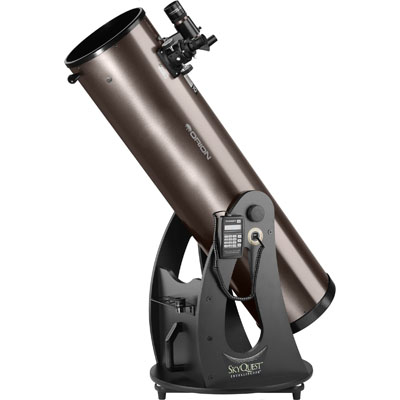
This large 10 inch Dobsonian is better suited for more advanced users. It does have a higher price but will be a lifetime investment. This motorized telescope comes with 2 Sirius Plossl eyepieces, a 25mm with 48x power magnification, and a 10mm with 120x power magnification.
The 9×50 right-angle correct-image finder helps you to easily locate the object you want to view. To organize yourself out in the field, there is an eyepiece rack to hold all the accessories for this best automatic telescope.
Use the push-to computerized IntelliScope Object Locator system that guides you to over 14,000 celestial objects. The IntelliScope’s Object Locator can also take you on a tour of the best sights to see in any month of the year.
With this best computer-controlled telescope, you will get amazing views of deep-sky objects, nebulas, star clusters, far-away galaxies, close-up views of the Moon’s craters and planets.
The large base has CorrecTension adjustment knobs that keep the telescope optical tube balanced in any viewing position. Dobsonian mounts stand out for their ease of use. The base features a CorrecTension system that ensures smooth manual tracking control as you follow an object across the sky.
I always look for electric telescopes that come with loads of educational information. The Starry Night software package guides you to stars, constellations, planets, and other celestial objects that are visible on any day and time you choose.
What we liked
- Large 10-inch aperture on this tracking telescope
- 2 eyepieces, Sirius Plossl 25mm and 10mm
- SkyQuest IntelliScope System
- IntelliScope object locator hand controller
- Orion 9X50 finderscope
- Telescope eyepiece rack
- Collimation cap
What we didn’t like
- Higher price
- Heavy, not easily portable
- Learning curve to get started
Optical Type: Dobsonian Reflector
Aperture: 254mm (10 inch)
Focal Ratio: f/4.7
Magnification: 48x, 120x
Weight: 55.3 lbs (25 kg)
Mount: Dobsonian
10. Orion SkyQuest XT10g Automated GoTo Telescope
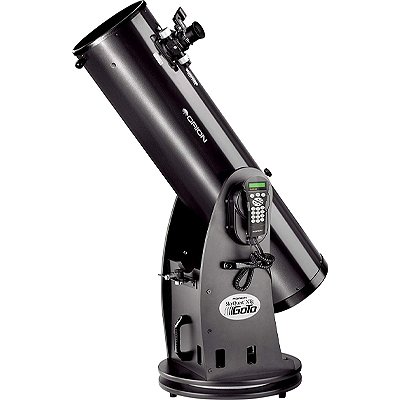
The Orion SkyQuest XT10g Computerized GoTo Telescope is our favorite choice for the intermediate user.
With a 10” (254 mm) aperture, you’ll be able to view galaxies, nebulas, star clusters, as well as planets and stars with excellent clarity.
The hand controller is intuitive and straightforward for regular users, and it includes a database of over 42,000 objects.
The GoTo design is seamless, and, with the included GPS, aligning and adjusting the scope is effortless.
There are few problems with this telescope, but the only issues that arise with this beast of a telescope are minor quips. The software for the hand controller is reportedly shipped with an older version, which requires updating. The power cord is not included, which is an odd thing to leave out, and it requires an external power source.
Overall, it’s an excellent GoTo telescope for both beginners and advanced observers. However, at that price point, it’s the best motorized telescope option for seasoned astronomers with larger budgets.
What we liked
- Ultimate seasoned-astronomer experience
- Fantastic optics for viewing distant planets and DSOs
- Intuitive hand controller
- Extensive object database and effortless alignment
- Both firmware and software is well-designed and well-made
What we didn’t like
- Power cord not included
- Some hand controllers are shipped with older software with issues (update fixes this, though)
Optical Type: Reflector (Dobsonian)
Aperture: 254mm
Focal Ratio: f/4.7
Magnification: 36x, 300x
Weight: 68 lb
11. Orion StarBlast 6i IntelliScope Reflector Telescope
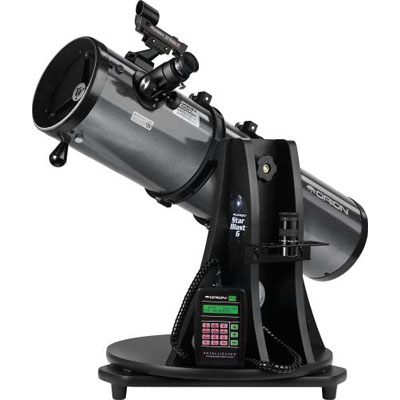
If you are looking to upgrade to a computerized telescope, the Orion StarBlast 6i Intelliscope Reflector Telescope is a perfect choice. It is well priced and ideal for a family wanting to expand their knowledge and become intermediate-level stargazers.
With a huge 6″ aperture and 750mm focal length, you will get sharp views of the Moon and bright planets like Mars, Jupiter, and Saturn. You will also enjoy seeing deep sky objects like nebulas, galaxies, and sparkling star clusters.
What I like most about this self aligning telescope is the portability and the tabletop mount that make it so easy to set up and operate. The telescope comes with Orion’s IntelliScope computerized object location system.
This allows you to find any celestial object by using the easy-to-use handheld locator. By manually slewing the telescope according to the directional arrows, you can pinpoint objects in space and place them into your field of view in seconds.
The automated telescope comes with 2 eyepieces, a Sirius Plossl 1.25″ 25mm and a 10mm. You also get a handy eyepiece rack to hold your accessories. The Starry Night Software Package guides and shows you what to look for and when. If you are not sure, simply press the Tour Button to select one of 12 tours of the best objects visible in any month you choose.
What we liked
- Very well priced for exceptional features
- Large 6” aperture
- 2 eyepieces, a 25mm and a 10mm
- Table-top motorized mount
- Best computerized telescope for viewing galaxies
- Lightweight and portable
- Easy to use with the handheld locator
What we didn’t like
- Doesn’t come with a GoTo mount
- Some users prefer a full size mount
Optical Type: Reflector
Aperture: 150mm (6 inch)
Focal Ratio: f/5
Magnification: 30x, 75x
Weight: 25 lbs (11.3 kg)
Mount: Altazimuth
12. Orion StarSeeker IV 127mm Mak-Cass GoTo Telescope with Controller
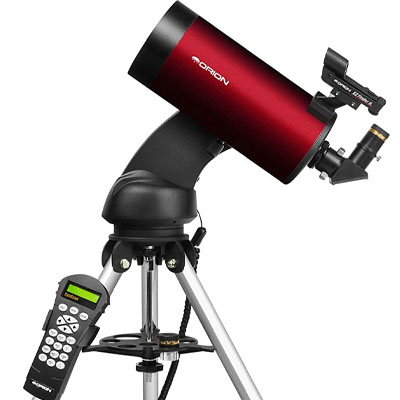
Sit back, relax and let this best goto telescope track your celestial object! This is the best way to view the night sky. The powerful 5″ GoTo Mak-Cass has a long 1540mm focal length for amazing views of the Moon, planets, and deep-sky objects.
This automatic tracking telescope comes fully equipped with two AFOV eyepieces, a 23mm wide-field 60°, and a 10mm wide-field 60°.
Also included is a 1.25″ Star diagonal for easy viewing. Once you get into it, the telescope is easy to align. The dual optical encoders on both axes of motion allow manual aiming of the telescope without losing your GoTo alignment.
After your object is in sight, the StarSeeker IV 127mm locates and tracks it automatically for you as it moves across the sky. Weighing only 22.2 lbs, it is easy to take along on a stargazing vacation.
This is a slightly more expensive goto telescope, but it offers great value for money and a host of features for advanced stargazers. It has a GoTo hand controller and EZ Finder II sight for smooth and fast locating of objects.
To help you get started, there is a DeepMap 600, a MoonMap 260, and a large GoTo database of over 42,000 objects. For family viewing fun with this automatic telescope, you can follow a built-in Tour.
What we liked
- 5” aperture, 1540mm focal length
- 2 eyepieces, AFOV 23mm and 10mm
- StarSeeker IV GoTo Altazimuth Mount and Tripod
- Computerized GoTo Hand Controller
- Orion EZ Finder II reflex sight
- Accessory tray
- Hand controller holder bracket and strap
What we didn’t like
- Some users had trouble with the mount
- Has some learning curve
Optical Type: Maksutov-Cassegrain
Aperture: 127mm (5 inch)
Focal Ratio: f/12.1
Magnification: 67x, 154x
Weight: 22.2 lbs (10 kg)
Mount: GoTo Altazimuth
Types of Computerized Telescopes
Computerized telescopes are broken up into two categories, motorized, also known as “GoTo,” and non-motorized.
GoTo Telescopes
GoTo telescopes have an electronic motor that’s connected to the included computer, which allows the user to input locations, and the telescope will automatically go to them.
They’re user-friendly, sleek, and you don’t have to do things manually.
GoTo telescopes are extremely helpful for beginners, but they’re also useful to seasoned enthusiasts seeking to save time as they scan the cosmos.
The big disadvantage of a computerized telescope is that it makes things “too easy,” which we really don’t think is that big of a deal!
Non-motorized Telescopes
Non-motorized versions are similar in that they still have a computer, but you have to manually move and adjust the telescope to the desired location (the computer provides instructions).
This could be considered the downside of non-motorized versions, but many argue that the non-motorized versions are better for beginners.
They make scanning for objects easier while not providing the motorized “crutch.”
Overall, they can both be great for beginners, but non-motorized telescopes offer the opportunity to learn the ropes of the manual adjusting process using guided instructions.
Computerized Telescope Price Timeline
Dissimilar to traditional reflector and refractor telescopes, the price ranges for computerized telescopes are easier to navigate. In general, motorized telescopes are inexpensive and you can typically find a good quality one for under or around $500.
Under $100
Anything under $100 is considered a cheap computerized telescope. These telescopes, while very inexpensive, are not typically worth buying—it’s best to spend a bit more and get something with higher quality.
Budget: $100-$300
Telescopes residing in the $100 to $300 range are typically decent quality, and they’re a good choice if you’re on a tight budget. We recommend getting something around $300 if you can, though.
Mid-range: $300-$600
This is the perfect range for someone who’s interested in jumping into astronomy, or an intermediate astronomer looking to upgrade their old equipment.
High-end: $600-$1,000
A higher-end computerized telescope will cost you about $600 or more. Optics and overall viewing quality begin to take a leap-up at this point.
Seasoned Astronomer: $1,000+
This range is primarily for seasoned astronomers who want to upgrade their viewing experience, and also don’t have too much of a budget. Telescopes in this range provide a gorgeous viewing experience, but that’s why they’re more expensive.
Also read: 5 Best Solar Telescopes in 2020 [to Observe The Sun]
Don’t Forget the Power Source
Before buying a computerized telescope, it’s essential to determine where you’ll be using it most. Where you plan to use, it plays a part in what other accessories you need, especially when it comes to power.
- These types of telescopes always require electricity to operate (obviously), so you’ll need a stable power source if you want to view the night sky uninterrupted.
- If you’re using it at home, for instance, you can simply plug your telescope into an outlet in or outside of your home. However, if you’re using it somewhere remote, you’ll need a portable power supply.
Both options can affect the overall price and the portability of the telescope. Most portable power sources for telescopes have an adapter that you can plug into your vehicle, but if you’ve ever tried that before, it kind of ruins the experience (you’ll be wondering if your car battery will die the whole time). Adding a portable power source also affects the overall weight of your telescope, which is crucial to remember if you plan on hiking with it!
Also read: 5 Best Travel Telescopes in 2020 [Portable & Durable]
Also read:
- 5 Best Telescope Eyepieces in 2020 [+Beginner’s Guide]
- 5 Best Telescopes for Viewing Planets in 2020 [Saturn, Mars, Jupiter, etc.]
- 5 Best Dobsonian Telescopes in 2020 [From 8 to 12-inch Options]
How to Choose the Right Computerized Telescope?
Aperture
Apertures can range from a smaller 5 inch to a large 10 inch, or 11 inch. The larger the aperture, the more costly the telescope will be. Telescopes with larger apertures are also bigger and are sometimes less portable. 6 inch or 8-inch digital telescopes will give home stargazers great views of the night sky at mid-range prices.
Magnification
This relates to the eyepieces you get with computer telescopes. Some models come with more than one eyepiece, offering a choice of magnifications. Power magnifications can be anything from 25x to 125x or more. Higher magnification does not always mean that you see a clearer image, as very large images can become distorted.
Focal Length
This is effectively the length of the telescope. Focal lengths on the telescopes we reviewed range from 750mm to a large 2800mm on the more expensive models. The longer the focal length the better views you will get. Look for 750mm to 1500mm as a starting point in a beginner to an intermediate telescope.
Size and Weight
The first question is, do you want to travel with your scope or do you have a permanent place to set it up at home? If you want to take it on trips to darker observation sites, you need a light and portable scope. Weights can vary between 20 lbs and 80 lbs. Look for a best digital telescope that weighs around 25 lbs to 40 lbs for easy portability.
GPS
A GPS-powered telescope makes the alignment procedure much easier. You do not need to enter dates, times, or location. The GPS automatically fetches the information from satellites and knows exactly where you are on the planet. Many computer telescopes have connections for attaching a GPS. Some more expensive models have a built-in GPS System.
GoTo vs. Manual
Are you a classic viewer or a fan of apps and computerization? GoTo telescopes can automatically locate and track your object, making it easier for beginners to start stargazing. They do cost more than manual telescopes. With a manual telescope, it is up to you to locate and align your telescope on the object you want to view.
FAQ
What is a computerized telescope?
A computerized telescope has a mount with computer software that lets you input coordinates or select an object from a database. The telescope will then find the object for you. You will not have to locate it manually.
Is a computerized telescope worth it?
Yes – it is a great way for beginners to start stargazing fast and easily. Sometimes beginner home astronomers become frustrated trying to locate sky objects. Computerized telescopes remove this problem.
Can you connect a telescope to a computer?
Yes, you can. Computerized or GoTo telescopes connect to software on an App or on a mobile device. This allows you to easily locate and align to celestial objects.
What is the best computerized telescope for beginners?
The Orion StarBlast 6i IntelliScope Reflector Telescope is best for a beginner. It is well priced with exceptional features. It has a large 6” aperture, 2 eyepieces, and a portable table-top motorized mount.
What is the best computerized telescope under $500?
The Celestron NexStar 130 SLT Newtonian Reflector Telescope costs just under $500. It is a great choice with a 5 inch aperture, 2 eyepieces, and a lightweight, portable construction.
What is the best computerized telescope under $300?
For under $300 you will find it difficult to get a decent computerized telescope. If this is your fixed budget then rather look for a well-priced manual telescope. If you can increase your budget, both the Celestron NexStar 130 SLT Newtonian Reflector and the Orion StarBlast 6i IntelliScope Reflector are priced under $500.

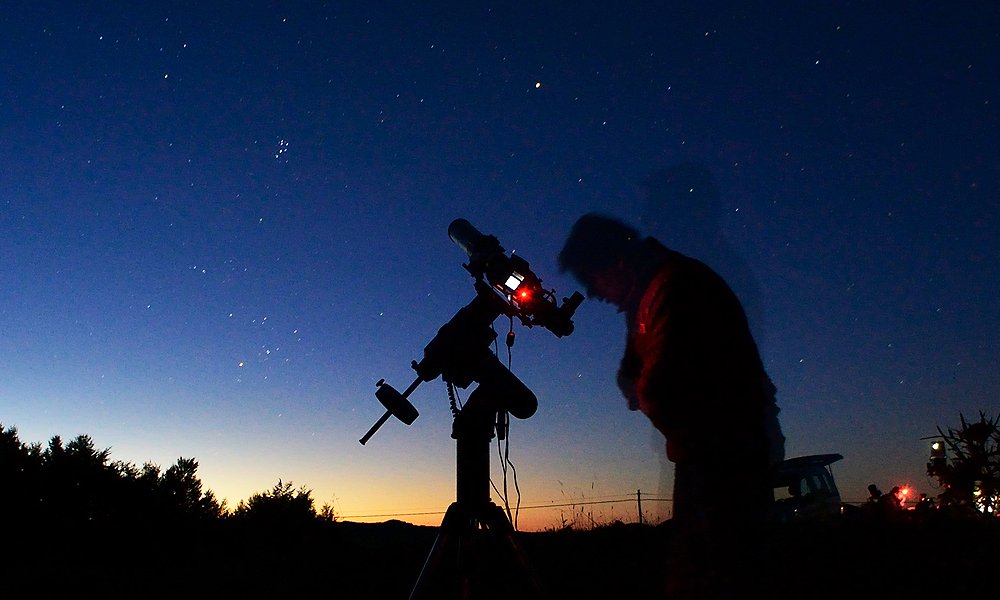
![12 Best Travel Telescopes in 2024 [Portable & Durable]](https://www.planetguide.net/wp-content/uploads/2019/12/best-travel-telescope-768x461.jpg)
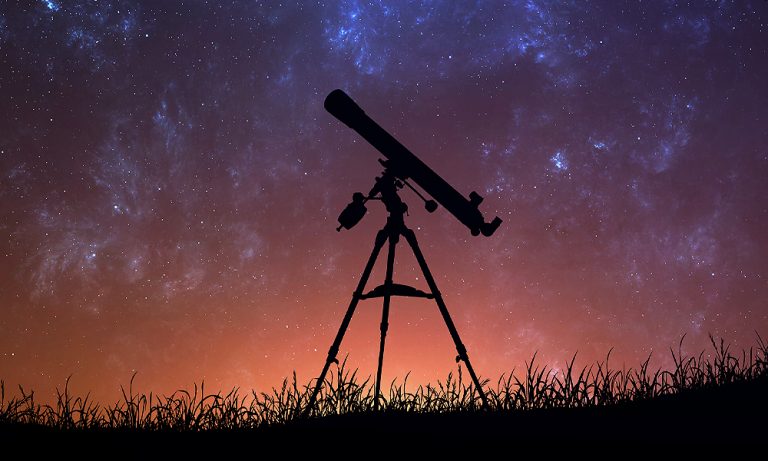
![12 Best Telescopes for Deep Space Objects [2024]](https://www.planetguide.net/wp-content/uploads/2019/12/Depositphotos_144986289_l-2015-768x512.jpg)
